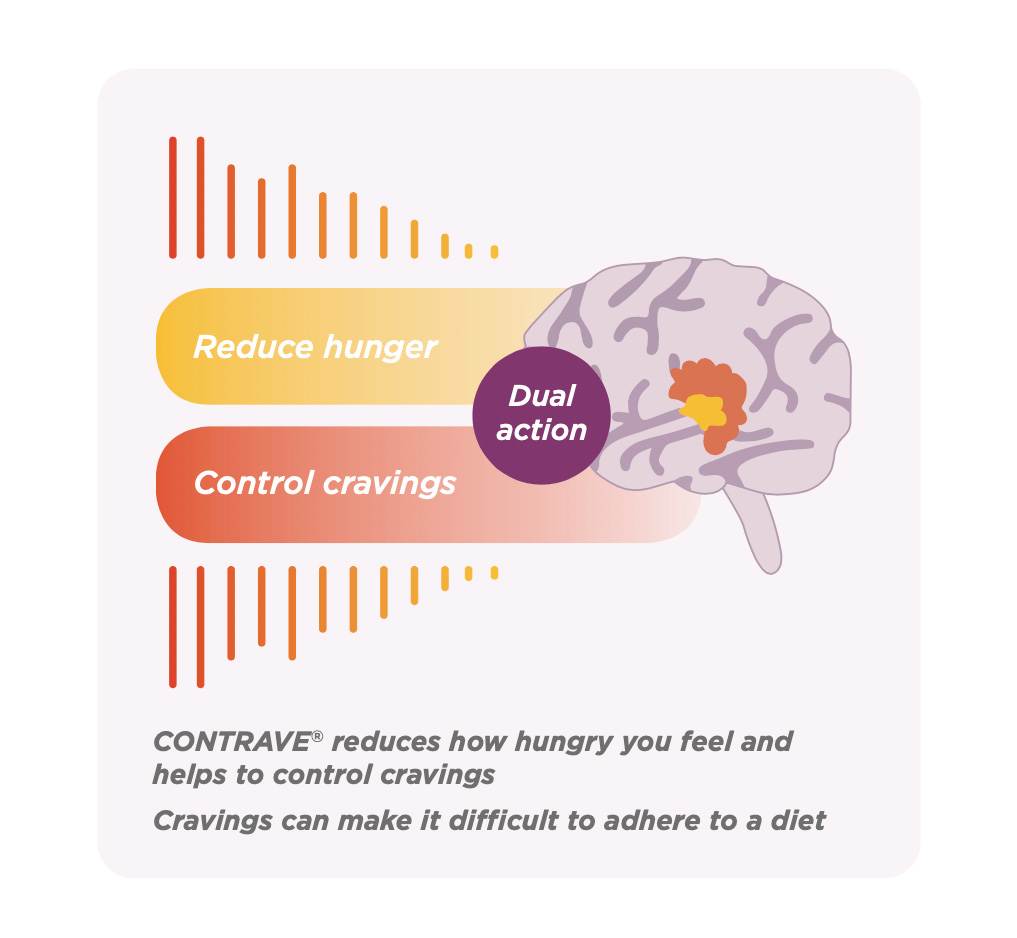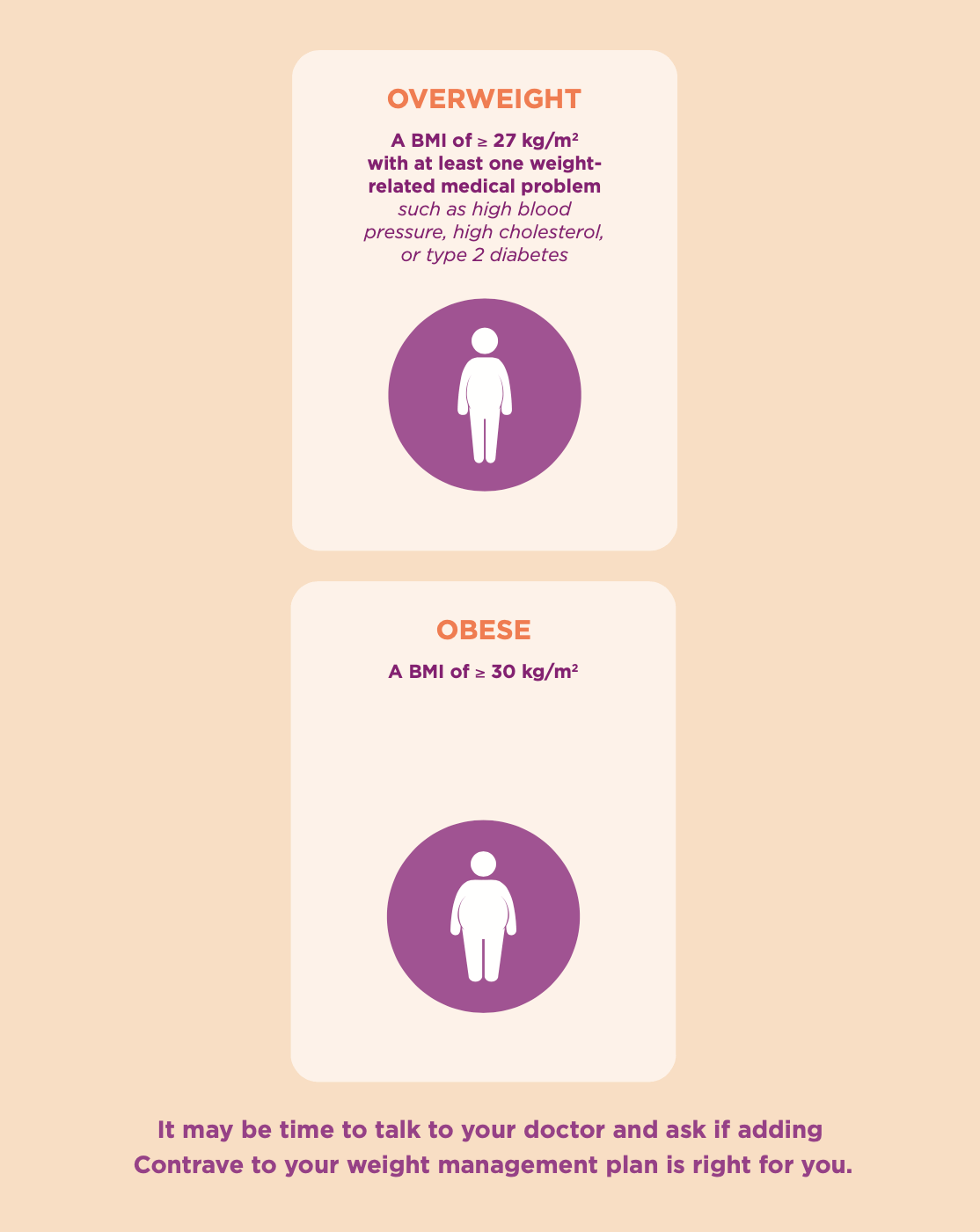Contrave®
The prescription medicine that helps control hunger and cravings

Contrave is a prescription weight-loss medicine designed to help people who are overweight achieve a healthier weight.
Studies have shown that people who take Contrave as part of a diet and exercise plan lose more weight than diet and exercise alone.
Try a different way with Contrave.
How Contrave works
Exactly how Contrave works to reduce weight isn’t entirely understood. However, Contrave’s dual-acting formulation is thought to work on two separate areas of the brain to help reduce hunger and cravings – giving you a better chance at sticking to a reduced calorie diet.
Contrave is an oral medicine (tablets) that can help people achieve a healthier weight when taken in combination with diet and exercise.
Specifically, Contrave may help to:
- Increase the feeling of being full
- Reduce food intake
- Reduce food cravings

Who is Contrave for?
Contrave is indicated for adults (18 years or older) with a Body Mass Index (BMI) ≥27 kg/m2 with at least one weight related co-morbidity, or BMI ≥30 kg/m2 who have not been successful in managing their weight with diet and exercise alone.


How much does Contrave cost
Contrave is not funded so there will be a cost. The recommended retail price for Contrave is $240 per month, or around $9 per day, which is less than a latte and pastry – and hopefully you won’t need the pastry!
Normal doctor’s fees and pharmacy charges apply. While the cost of the medication is usually the same, pharmacy dispensing fees can vary between pharmacies.
Does Contrave have side effects?
All medicines can have side effects and Contrave is no different; most of them are minor and temporary. However, some side effects may need medical attention. If you experience side effects, and they worry you, then talk to your doctor or pharmacist.
The most commonly reported side effects with Contrave include nausea, constipation, headache, vomiting, dizziness, and dry mouth. These are not all the possible side effects of Contrave, for more information on side effects, read the Consumer Medicines Information (CMI) here.
Most side effects are temporary (often only within the first 4 weeks), and nausea (the most common) was reported by less than 1% of patients after week 6 of treatment
If you are experiencing side effects, talk to your doctor about how to best manage them.
Common weight loss options
Committing to changes in your lifestyle is essential for long-term weight management. If you want to lose weight and keep it off, you need to change your energy balance by taking in less energy (calories) than your body uses.
Lifestyle changes
Lifestyle changes includes altering your diet (eating habits) and increasing exercise. It can also include changing your behaviour, which means getting an understanding of the factors and/or behaviours that have contributed to you becoming overweight or have stopped you from losing it. Your GP may be able to offer advice or provide a referral to a psychologist, counsellor or behavioural therapist if required.


Pre-prepared meals and VLED products
Various commercially prepared meal programs are available. These can help by providing energy-controlled meals. Other options include VLED (very low energy diet) products and meal replacements.
A VLED product (e.g. shakes and bars) can be used to replace all or some meals. This option should be used with supervision from our GP as part of a weight management program. VLEDs should not be confused with meal replacements. Meal replacements are not nutritionally complete, so there is a danger you could end up with malnutrition if you ONLY eat meal replacements.
Medicine
Weight reducing medicine may be used as part of an overall weight loss program that includes diet, exercise and behaviour changes. There are several weight loss options available in New Zealand.

Weight loss surgery
Surgical treatments are often considered as the last resort, as they are only suitable in people with a high BMI. Weight loss surgery is quite expensive and can be difficult to access. That said, surgical treatments are an effective way for severely obese people to lose weight.
There are three common surgical weight loss options available; adjustable gastric banding (the most common surgical method used in New Zealand), gastric bypass (which changes the way the stomach and intestine handle food) and gastric sleeve (which reduces the size of the stomach).
Any surgical or invasive procedure carries risks. Before proceeding, you should seek a second opinion from an appropriately qualified health practitioner.